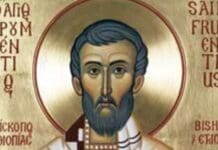 St. Elizabeth is usually depicted in royal garb with a dove or an olive branch. At her birth in 1271, her father, Pedro III, future king of Aragon, was reconciled with his father, James, the reigning monarch. This proved to be a portent of things to come. Under the healthful influences surrounding her early years, she quickly learned self-discipline and acquired a taste for spirituality. Thus fortunately prepared, she was able to meet the challenge when, at the age of 12, she was given in marriage to Denis, king of Portugal. She was able to establish for herself a pattern of life conducive to growth in God’s love, not merely through her exercises of piety, including daily Mass, but also through her exercise of charity, by which she was able to befriend and help pilgrims, strangers, the sick, the poor—in a word, all those whose need came to her notice. At the same time she remained devoted to her husband, whose infidelity to her was a scandal to the kingdom.
St. Elizabeth is usually depicted in royal garb with a dove or an olive branch. At her birth in 1271, her father, Pedro III, future king of Aragon, was reconciled with his father, James, the reigning monarch. This proved to be a portent of things to come. Under the healthful influences surrounding her early years, she quickly learned self-discipline and acquired a taste for spirituality. Thus fortunately prepared, she was able to meet the challenge when, at the age of 12, she was given in marriage to Denis, king of Portugal. She was able to establish for herself a pattern of life conducive to growth in God’s love, not merely through her exercises of piety, including daily Mass, but also through her exercise of charity, by which she was able to befriend and help pilgrims, strangers, the sick, the poor—in a word, all those whose need came to her notice. At the same time she remained devoted to her husband, whose infidelity to her was a scandal to the kingdom.
He too was the object of many of her peace endeavors. She long sought peace for him with God, and was finally rewarded when he gave up his life of sin. She repeatedly sought and effected peace between the king and their rebellious son, Alfonso, who thought that he was passed over to favor the king’s illegitimate children. She acted as peacemaker in the struggle between Ferdinand, king of Aragon, and his cousin James, who claimed the crown. And finally from Coimbra, where she had retired as a Franciscan tertiary to the monastery of the Poor Clares after the death of her husband, she set out and was able to bring about a lasting peace between her son Alfonso, now king of Portugal, and his son-in-law, the king of Castile.

















